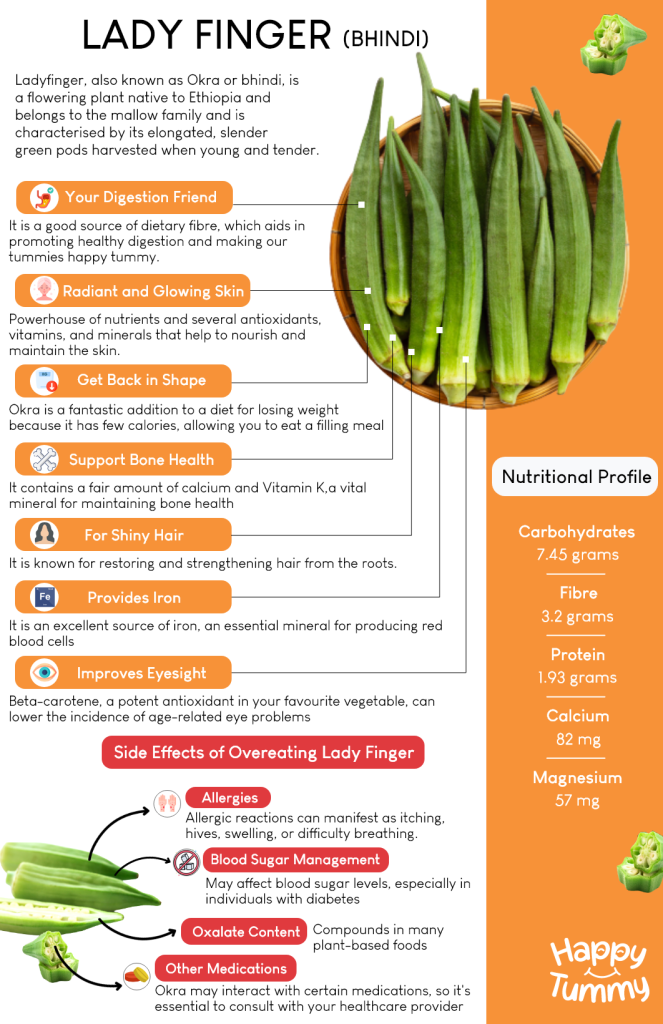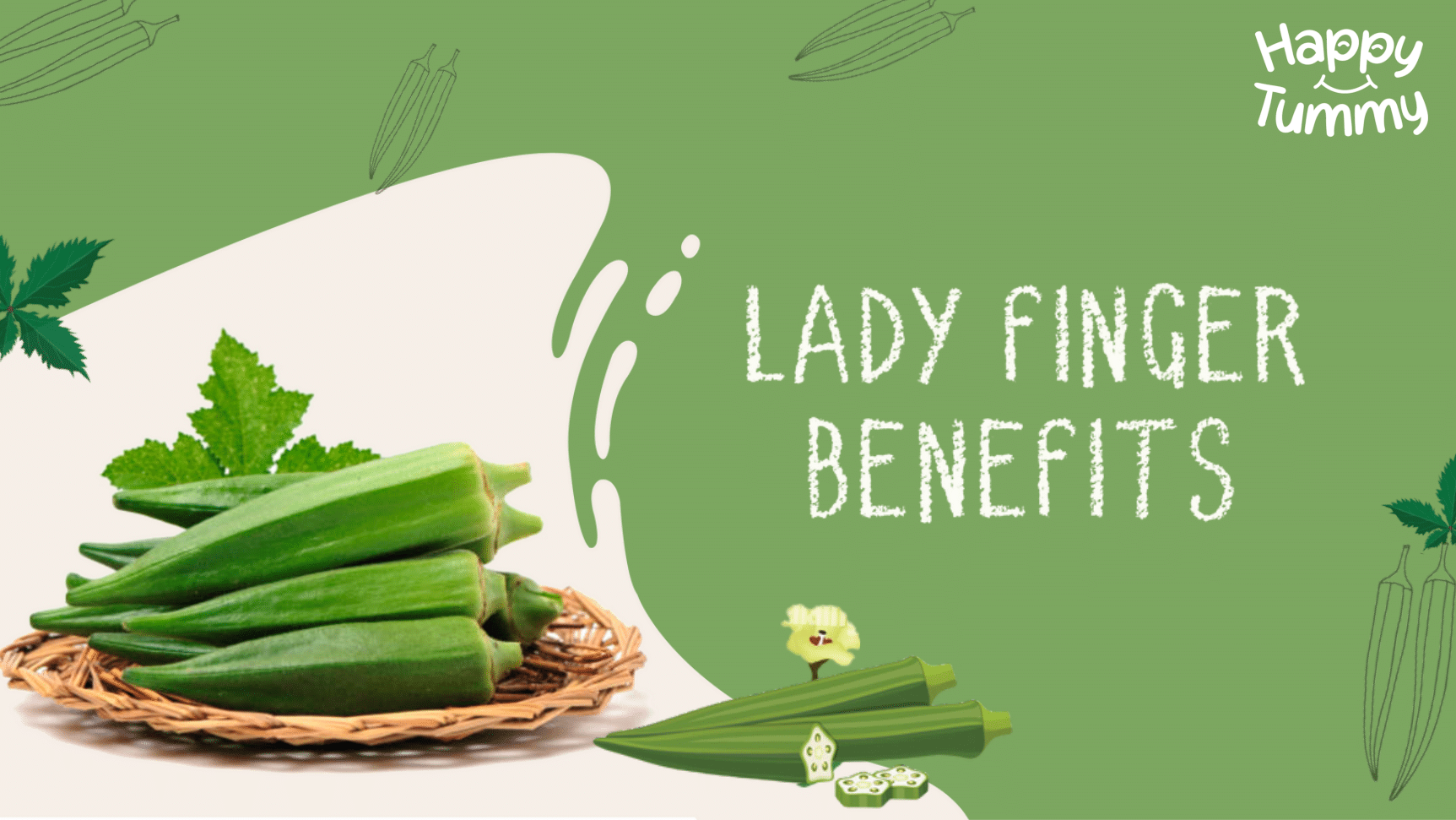Table of Contents
Not all superheroes wear capes. You heard it right. Superheroes like Hulk, Captain America, Iron Man, and Spider-Man have all saved the world. Have you, however, ever heard of a veggie superhero? So, it’s time to welcome the incredible Lady Finger, Okra, or Bhindi (it doesn’t matter what name you call them), which offers many health benefits.
Prepare to be astonished as we unveil the untold secrets of lady finger’s incredible benefits.
From helping in digestion to strengthening bones, bhindi’s astonishing benefits will leave you in awe. It is a vegetable that can be utilised in various recipes.
It is a tasty vegetable that is both healthful and nutritious and offers several health advantages.
The benefits of Okra go beyond its incredible nutritional value.
So, let’s prepare to delve into a captivating journey where you will find some exciting things about this common vegetable, which will not be so ordinary after you read it.
Discovering Lady Finger – Everything You Wish to Know
Ladyfinger, also known as Okra or bhindi, is a flowering plant native to Ethiopia and widely cultivated in tropical and subtropical regions worldwide.
It belongs to the mallow family and is characterised by its elongated, slender green pods harvested when young and tender.
Bhindi is a flexible vegetable in various culinary styles with a mild flavour and distinctive texture.
It can get slimy when cooked due to its natural mucilage content, which is liked in meals like stews, curries, stir-fries, and pickles. It is tasty, nutrient-dense, and provides several health advantages.
Know the Nutritional Profile of Your Superhero – Lady Finger (Bhindi)
Before we move on to understand the lady finger benefits, it will be a good idea to know about the nutritional value it offers to us. In 100 grams portion of Okra, you will get the below nutritional components [1]:
| Name | Amount |
| Carbohydrates | 7.45 grams |
| Fibre | 3.2 grams |
| Protein | 1.93 grams |
| Calcium | 82 mg |
| Magnesium | 57 mg |
Finding Lady Finger’s Potential Health Benefits

Okra, usually called lady finger, is a well-liked veggie with several health advantages.
It is a good source of vitamins, minerals, dietary fibre, and antioxidants, all of which support improving the digestive system’s health.
All and many more of such health benefits make lady finger a great addition to any diet. Let’s explore some of these now:
1. Lady Finger(Okra) improves digestion
To your surprise, Lady Finger is known to be beneficial for digestion due to its high fibre content and mucilage properties [2].
It is a good source of dietary fibre, which aids in promoting healthy digestion and making our tummies happy tummy. Fibre gives the stool bulk, which makes it simpler to transit through the digestive system and avoids constipation.
Additionally, it promotes regular bowel motions and lowers the possibility of digestive problems, including cramps and bloating.
My Meal Plan
If you wish to know the percentage of fibre present in the dishes you make with bhindi, check it out on My Meal Plan. An initiative by Aashirvaad Atta with Multigrain that decodes the fibre value in every item on your plate.
Mucilage – Lubricating the digestive system
Additionally, mucilage, a unique compound that occurs when the vegetable comes into contact with fluids, is only found in okra.
The function of mucilage in lubricating the digestive system allows for the effortless flow of food through the intestines. It can encourage a healthy digestive flow and aid in relieving constipation.
Amylase and lipase, two enzymes that aid in the digestion of fats and carbs, are also present in this great vegetable.
These enzymes help break down complex dietary molecules into more easily absorbed and utilised forms for your body.
Bhindi also serves as a prebiotic, feeding healthy intestinal microbes. These intestinal microbes are essential for preserving a sound digestive system.
Digestive Quotient Test
This versatile vegetable supports a balanced gut microbiome and general digestive health by encouraging the growth of these helpful bacteria.
Who would have imagined that a simple green vegetable, often a favourite of every child, can do wonders and keep our tummies happy?
If you wish to explore more about your digestive health, you should check the digestive quotient test by Aashirvaad Atta with Multigrain. With simple questions to answer, you can check what your digestion score out of 100 is.
2. Okra for weight management
Want to shed some extra pounds, make bhindi your best friend. If you are wondering how let us tell you.
Okra is a fantastic addition to a diet for losing weight because it has few calories, allowing you to eat a filling meal without worrying about eating too many [3].
Bhindi is also a great source of dietary fibre, which encourages satiety and aids in appetite management. Fibre gives your food more bulk, which helps you feel satisfied for longer and less likely to overeat or snack between meals.
3. Lady Finger (Okra) for skin health
Okra is a powerhouse of nutrients that help maintain good skin health [4]. Surprised, even we were. It has several antioxidants, vitamins, and minerals that help to nourish and maintain the skin.
The high quantities of vitamins A and C enhance skin suppleness and combat free radicals.
Okra, conversely, contains vitamin E, which lessens irritation and shields the skin from sun damage. Besides, it is also rich in magnesium, which helps to reduce skin inflammation and promote healthy cell turnover.
Okra’s high water content also aids in hydrating and preventing dry skin.
Okra also contains potassium and zinc, which help minimise puffiness, dark circles around the eyes, and acne and blemishes.
4. Lady Finger supports bone health
Lady Finger contains a fair amount of calcium, a vital mineral for maintaining bone health [5]. One must consume enough calcium to build and maintain healthy bones and teeth. It also has a high vitamin K content, particularly vitamin K1 (phylloquinone).
Vitamin K controls calcium metabolism and contributes to the mineralization of bones. It helps ensure that calcium is appropriately utilised and deposited in the bones.
5. Lady Finger (Bhindi) improves hair health
Didn’t we say you would be surprised by number 5? Who would have thought eating bhindi ki sabzi could be excellent for our hair [6]? Well, that is true. Okra is a perfect natural remedy for hair that has been used for centuries.
It is known for restoring and strengthening hair from the roots. Bhindi has many vitamins and minerals that hydrate the hair and scalp. It is also believed to encourage new hair growth and lessen hair loss.
Bhindi can be used in many ways to enhance your hair’s health.
You can apply a paste from its powder and water directly on the scalp. It will help soothe and moisturise the scalp, promoting hair growth.
Before using the paste on the scalp, some honey & a few drops of lemon juice can be added. It will assist in clearing the pores and enhancing scalp blood flow.
You can also use lady finger juice or extract to massage your scalp. It will help improve the scalp’s blood flow and stimulate hair growth. Finally, you can use its powder to make a hair mask.
Apply the powder to your hair after mixing it with honey and yoghurt. Your hair will benefit from nutrition and maintenance.
6. Eat Lady Finger for Iron
The Lady finger is an excellent source of iron, an essential mineral for producing red blood cells [7]. It has been used for a very long time in conventional medicine to treat anaemia and other conditions brought on by a shortage of iron.
It contains non-heme iron, a type of iron that is found in plants.
Bhindi and other foods high in vitamin C help the body better absorb non-heme iron, which is not as easily digested by the body as heme iron (found in animal sources).
7. Lady Finger helps in improving eyesight
Beta-carotene, a potent antioxidant in your favourite vegetable, can lower the incidence of age-related eye problems [8].
Additional antioxidants that shield the eyes from UV rays and other harmful environmental elements are lutein and zeaxanthin. Bhindi use regularly can improve overall eye health and help prevent vision loss.
Additionally, this fantastic vegetable contains vitamin A, essential for maintaining good vision.
Should You Be Worried About Eating Lady Finger?
Can anyone think of any side effects linked with a vegetable such as bhindi? Don’t worry; bhindi is a safe vegetable to be consumed by everyone. But there is no harm in knowing and understanding if there are any lady finger side effects. Let’s look at them:
- Allergies – Some people may be allergic to bhindi or specific proteins. Allergic reactions can manifest as itching, hives, swelling, or difficulty breathing. If you experience any allergic symptoms after consuming lady finger, it’s essential to seek medical attention immediately.
- Oxalate Content – Your favourite vegetable contains oxalates, naturally occurring compounds in many plant-based foods. Unless you have a history of calcium oxalate stones or are at risk for kidney stones, oxalate-rich foods should be consumed in moderation.
- Blood Sugar Management – Okra may affect blood sugar levels, especially in individuals with diabetes or those on blood sugar-lowering medications. It has a low glycemic index, but it is advisable to monitor blood sugar levels closely when incorporating it into the diet.
- Other Medications – Okra may interact with certain medications, so it’s essential to consult with your healthcare provider to determine if any potential interactions or adjustments to medication doses are necessary.
Closing Thoughts on Lady Finger
Lady Finger is a remarkable vegetable with versatility, nutritional value, and potential health benefits.
From its fibre-rich content aiding digestion to its vitamin and mineral composition supporting various aspects of health, it has earned its place in a well-balanced diet.
Whether you seek to enhance your immune system, improve your skin and hair health, support bone strength, or simply explore its culinary delights, bhindi offers a unique and flavorful experience.
Remember, every person may respond differently, and it’s essential to listen to your body and seek personalized advice when necessary.
But remember to embrace the wonders of bhindi and discover the incredible ways this humble vegetable can contribute to your well-being and culinary adventures.
FAQs
Bhindi is a safe vegetable to eat, and it’s unlikely that you’ve heard of any adverse effects, but if you have allergies to any proteins or chemicals, you should talk to your doctor before adding it to your diet.
Besides being everyone’s favourite vegetable, bhindi also offers numerous health benefits. One of the most significant advantages of consuming it is promoting digestive health. Okra helps resolve the constipation problem by loosening the stool and letting it pass quickly. Moreover, it has other benefits such as skin and hair health, eyesight and bone health, etc.
Yes, bhindi is safe to eat for those who have diabetes. Before adding it to your diet, you must always see your doctor.
Even though bhindi is relatively healthy, some people should avoid eating it. Bhindi is a part of the mallow family, so those allergic to pollen should stay away from it.
You should try not to pair bitter gourd with bhindi or okra. It is because these vegetables together can create trouble or imbalance in your stomach. Therefore, one should avoid mixing both these vegetables.
Yes, you can eat curd and bhindi together. People often make a dish that involves using curd during the preparation of bhindi.
















